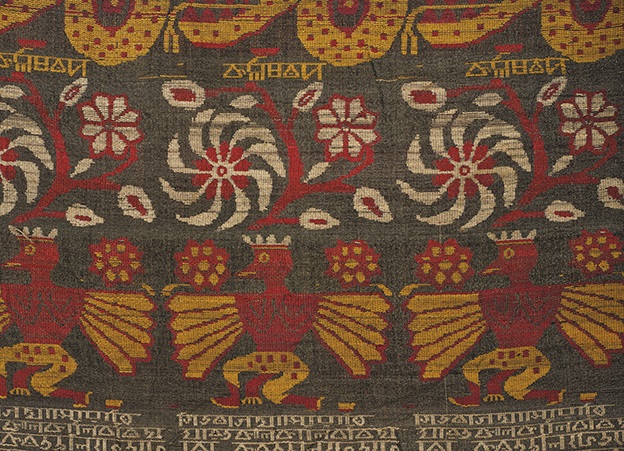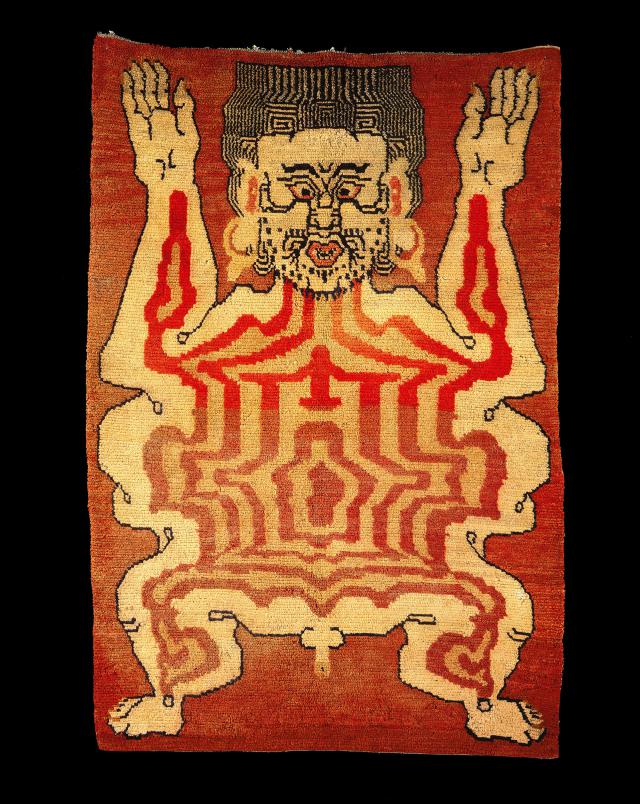
It was a pleasure to see so many members take part in our recent AGM, and even more so that several of our overseas members were able to present textiles from their collections at the Show and Tell.
February certainly looks like being a busy month with lots of online talks and exhibitions. I’m listing them here in date order, as sadly several of them take place on the same date.

On 20 February there are no less than three online talks that I am aware of! The first of these is hosted by the Textile Museum, with Lawrence Kearney looking at American Coverlets for Rug Lovers. “In this virtual talk, carpet and textile dealer Lawrence Kearney will explore the varied art form of American wool coverlets from 1780 to 1830.
Woollen coverlets from the early 19th century are one of the great American art forms. They are often beautiful, plentiful and affordable. They were made, primarily, by itinerant weavers who travelled throughout New England and the Midwest from c. 1810 through the 1840s. After introducing the four main types of coverlets — over-shot, double-weave, winter-and-summer, and Jacquard-loomed (“figured and fancy”) — Kearney will explore the pleasures these 200-year-old woollen textiles can hold for rug lovers.” Textile Museum website.
Space for this session is limited so you are encouraged to register early.

Next is a Zoom Panel presented by WARP (Weave A Real Peace). This will take place at 1300 EST, which is 1800 in the UK. The panel will consist of Gunjan Jain, who “made a conscious switch from working for fast fashion industries to slow, sustainable fashion and set up Vriksh, a design studio that collaborates with handloom weavers in Odisha and other states in India. Uddipana Goswami …. a feminist peace researcher turned peace entrepreneur who promotes eco-conscious traditional/indigenous crafts from India’s conflict-ravaged Northeast periphery, and Maren Beck, [who with] her husband Joshua founded Above the Fray: Traditional Hill Tribe Art in 2007 in order to document, support, and introduce to the world the incredible traditional textiles arts and cultures of Laos and Vietnam.” Maren and Joshua are the co-authors of Silk Weavers of Hill Tribe Laos. This talk is free, but registration is essential!

If rugs are more your thing then the talk hosted by the New England Rug Society might be for you. This also takes place at 1300 EST on 20 February, when Alberto Levi will speak on Rugs of the Golden Triangle. “While in Tibet in the early ’90s, hunting, in his words, “for the next Seljuk animal carpet,” Alberto Levi “stumbled across an entirely different kind of animal.” In time, what seemed to be a casual encounter yielded a distinct group of carpets, which Alberto labels “Tibetan Golden Triangle.” Far from being Tibetan, this elusive family of rugs, most of them fragmentary, appears to originate from a triangular region defined at its extremes by eastern Anatolia, the southern Caucasus, and Northwest Persia. How and why these rugs ended up in Tibet is yet another part of the mystery that Alberto will investigate in his talk. ” NERS Newsletter. NERS members will automatically receive a link. Non-members wishing to attend should email committee member Jean Hoffman to receive theirs.

On Monday 22 February the Fowler Museum will host one of its regular Lunch and Learn sessions. Joanna Barrkman, the Fowler’s Senior Curator of Southeast Asia and Pacific Arts, will explore embroidered Jain temple and shrine hangings that offer insights into the religious beliefs and imagery of the Jain faith. This short talk will take place at 1430 PST which is 2230 GMT. Click here to register for this free event.
In addition to all of the above there is also the series of four talks hosted by the Textile Museum Journal that I covered in my previous blog. These are:- Elena Phipps on Brilliance, Colour and the Manipulation of Light in Andean textile Traditions (17th) , Raquel Santos and colleagues on Interdisciplinary Perspectives on Asian Textiles in Portuguese Collections (24th) and Walter Denny on Colour, Expectations and Authenticity in Oriental Carpets (26th). The talk by Dominique Cardon on Dyers’ Notebooks in Eighteenth Century England and France, which was scheduled for 10 February has been cancelled. However the good news is that one of Dr Cardon’s co-researchers, Dr Anita Quye, will now take her place for this talk on 10 March instead.

Don’t forget that the following day, Saturday 27 February, the Textile Museum Associates of Southern California will host an online talk by Alan Kennedy entitled Kesa: ‘Patchwork’ Buddhist Monks’ Robes in Japan, From Austere to Luxurious. This will take place at 10am Pacific time which is 1800 in the UK. “Kesa is the Japanese word for the traditional patchwork garment worn by Buddhist monks and nuns. These garments are among the earliest documented articles of clothing in Japan, based on inventory records dating to the 8th century. The history of kesa in Japan is of significance for both sacred and secular reasons. They served as a vehicle for both the transmission of Buddhism and of luxury textiles to Japan from the Asian mainland. Kesa that have been preserved in Japan are made of a wide variety of materials, ranging from monochrome bast fibre to sumptuous imported gold brocades. ….. This talk will survey kesa from its earliest history to modern times.” TMA/SC. Registration for this talk is available here.

A new exhibition opened this week at Kent State University Museum, which will run until 19 December 2021. Entitled Stitched: Regional Dress Across Europe this exhibition showcases common features shared by regional costume across Europe. “In its original context in villages, regional dress carefully marked social and cultural differences. Religious affiliation, gender, age, and marital status were all instantly recognisable at a glance by members of the community. A person’s outfit signalled which village or region they came from. Focusing on these signs of difference obscures the common vocabulary that rural residents across Europe used to shape their clothing. By organising the pieces on display according to shared features, this exhibition highlights the commonalities across the continent rather than their differences. The pieces on view span Western and Eastern Europe including examples from Norway, the Netherlands, Slovakia, Romania and Albania. The development of elaborate regional dress was not a result of the isolation of their wearers but a signal of their integration into broader European society.” KSU website.

The Shelburne Museum in Vermont was the first to exhibit quilts as works of art. Most of the pieces in their collection were produced in New England in the nineteenth century. They recently launched a new online exhibition entitled Pattern and Purpose: American Quilts, which features high-quality images of a selection of their quilts, along with detailed background information on each one. There is also an excellent video in which Katie Wood Kirchhoff previews the exhibition and explains more about the history of the collection and about certain specific quilts. The catalogue of quilt patterns produced by the Ladies Art Company certainly made me smile.

The Russian Museum of Ethnography has a new mini-exhibition which will run until 28 February. The subject is Glass Decor in the Traditional Costume of the Peoples of the Baltic and Barents Regions. The exhibition showcases textiles which are adorned using different types of glass decorations and were made in the second half of the eighteenth to the early nineteenth century. The quality of the images is very good, and there is a toggle at the top of the page to change the language to English.

The ethnographic collection of the Gapar Aitiev Kyrgyz National Museum of Fine Arts is highlighted in this article in Voices on Central Asia. In it Mira Djangaraсheva, the ex-director of the museum, Aigul Mambetkazieva, the chief conservator, and Chinara Daniyarova, a conservator, tell the story of the museum and describe some of its exhibits. The collection currently consists of over 18,000 items, including embroidered wall panels, felts, a fantastic pair of embroidered leather riding trousers and much, much more. Do take a look!

OATG member Sarah Fee, Senior Curator, Global Fashion and Textiles at the Royal Ontario Museum has informed us of the decision to extend the deadline for the IARTS Textiles of India grant until 15 May 2021. This biennial grant of $15,000 CAD “can be used anywhere in the world by anyone in the world toward a project that enhances knowledge about Indian textiles, dress, or costume”. The scope really is very broad, and can include research, fieldwork and creative work. Please click here for full details of how to apply.

Don’t forget the February issue of Asian Textiles will be out later this month. Our next online talk will be on 20 March when Genevieve Duggan will speak on People without history in eastern Indonesia, powerful or powerless? This will focus on the island of Savu, where Genevieve has conducted research over several decades. More details in my next blog!

